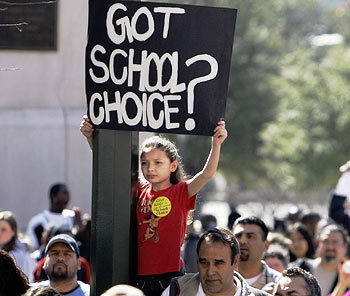McCain says the Native American graduation rate is around 50 percent, and according to Native American students’ ACT scores, there is a great disparity in college readiness compared to non-Native American students. In the English language arts category, less than 40 percent of Native American students scored high enough to be considered adequately ready for college. This is 25 percentage points lower than all students. In math, only one in five are college ready. Across all four traditional subject areas, data show barely 10 percent of Native Americans are college ready.
Native American students are being left behind in great numbers. This minority population is at the highest risk of any group in the nation of not receiving a proper education. Native American students deserve access to a quality education — just like every other student.
Arizona is one of only five states with an education savings account program. It is also home to the largest reservation in the country, the Navajo Nation, with a population of just under 175,000. The problem in Arizona is Native American students in schools run by the Bureau of Indian Education (BIE) are not eligible for the state’s ESA program. The Native American Education Opportunity Act would correct this problem by allowing students on reservations to have access to these funds. If passed, American Indian students would no longer be trapped in the poorly run BEI schools in Arizona.
BEI operates 183 schools across 23 states and 64 reservations and has a student population of around 42,000. The largest reservation populations are in Arizona, Montana, Nebraska, New Mexico, North Dakota, Oklahoma, South Dakota and Utah. Allowing ESAs to be utilized in states with large reservation populations would be one of the most significant education improvements for Native Americans in U.S. history. These students would be able to attend non-BIE schools, which could be private, virtual, tribal, a charter school, or a mix of learning facilities. The ESA would also allow the students to find tutors, pay for transportation to another school, pay for books, and pay for individualized instruction. The education opportunities would grow each year, allowing more and more students to escape failing government-run schools.
Some opponents of the legislation claim it would pull resources away from current BIE-run schools, leaving them worse off. While it is true BIE schools would not receive the same amount of funding as they have in recent years, their track record in educating students is dismal. Any private or charter school with a 50 percent graduation rate would be shut down as rapidly as possible. It is inhumane to force students to remain in a school that is failing to educate its students adequately. Opponents of ESAs are effectively saying they are more interested in keeping the failing money train moving in favor of government schools than they are of allowing students to find a quality education.
The lack of good educational opportunities on American Indian reservations has left many Native Americans in poverty. In the Navajo Nation, the unemployment rate is 42 percent, and 43 percent of the total population lives in poverty. On the Pine Ridge Reservation in South Dakota, unemployment is 80 percent, and 69 percent live in poverty.
While there are myriad reasons for the extreme unemployment and poverty rates, education plays a very important role in solving the problem. By providing a quality education, more students will be able to obtain a college degree. Currently, only 5 percent of Native Americans attend college immediately after graduating from high school, and only one in 10 of those who do attend college are able to graduate within four years. These numbers would dramatically rise over time if Native Americans are given the opportunity to utilize ESA programs, a move that would give every Native American student access to a much-needed quality education.





